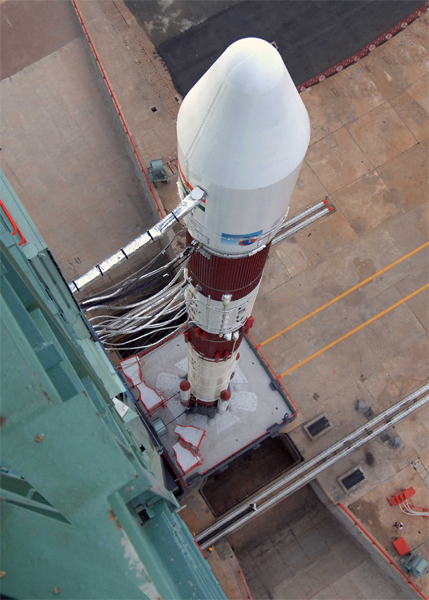PSLV Works — Again!

The rocket scientists at ISRO are indeed a happy bunch today:
In its sixteenth flight conducted from Satish Dhawan Space Centre (SDSC) SHAR, Sriharikota today (September 23, 2009), ISRO’s Polar Satellite Launch Vehicle, PSLV-C14 successfully launched the 960 kg Indian remote sensing satellite Oceansat-2 and six nano satellites for international customers into a polar Sun Synchronous Orbit (SSO). This was the fifteenth successful flight of PSLV. PSLV-C14
After a 51 hour count down, PSLV-C14 lifted off from the first launch pad at SDSC SHAR, at 11:51 am IST with the ignition of the core first stage. The important flight events included the separation of the first stage, ignition of the second stage, separation of the payload fairing at about 125 km altitude after the vehicle had cleared the dense atmosphere, second stage separation, third stage ignition, third stage separation, fourth stage ignition and fourth stage cut-off.
The 960 kg main payload, Oceansat-2, was the first satellite to be injected into orbit at 1081 seconds after lift-off at an altitude of 728 km. About 45 seconds later, four of the six nano satellites were separated in sequence. The initial signals indicate normal health of the satellites.
Oceansat-2 is the sixteenth remote sensing satellite of India. The state-of-the-art Oceansat-2 carries three payloads and has the shape of a cuboid with two solar panels projecting from its sides.
The eight band Ocean Colour Monitor (OCM) payload carried by Oceansat-2 images a swath (strip of land or ocean) of 1420 km width with a resolution of 360 metre and works in the Visible and Near Infrared region of the electromagnetic spectrum. The Ku-band Scatterometer with a 1 metre diameter antenna rotating at 20 rpm, works at a frequency of 13.515 GHz. The Scatterometer covers a swath of 1400 km and operates continuously. ROSA is a GPS Receiver for atmospheric sounding by radio occultation built by Italian Space Agency (ASI).
Soon after separation from PSLV fourth stage, the two solar panels of OCEANSAT-2 were automatically deployed. The satellite’s health is continuously monitored from the ISRO Telemetry, Tracking and Command Networks (ISTRAC) Spacecraft Control Centre at Bangalore with the help of a network of ground stations at Bangalore, Lucknow, Mauritius, Biak in Indonesia and Svalbard and Tromso in Norway as well as a station in Troll, Antarctica.
Here’s the video report, via Star News: